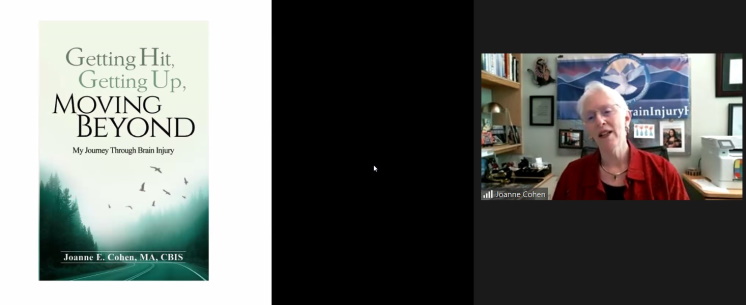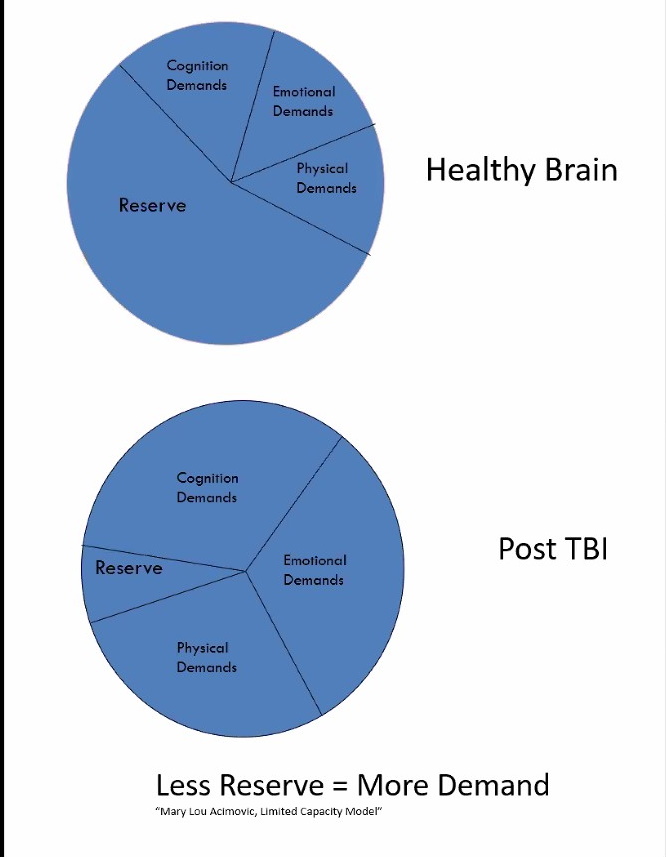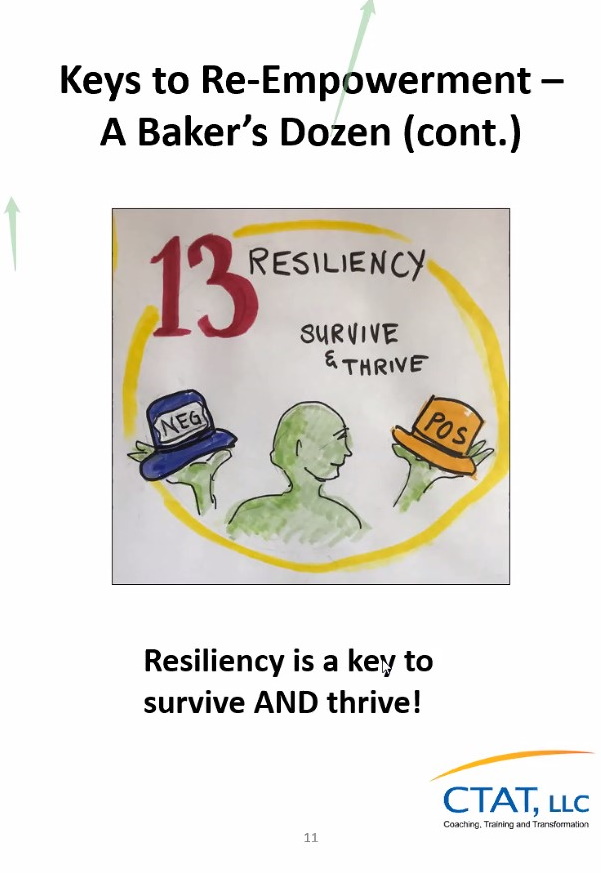A Positive Attitude Can Carry You Through Tough Times
By Eliza Marie Somers
We humans love routine, but after a brain injury, nothing seems routine. The simple act of brushing your teeth or making breakfast is anything but routine. How many times have you picked up something other than the toothpaste and started to put it on the toothbrush? Or looked in the fridge, only to draw a blank as to why you opened it in the first place? Or walked into your office only to forget why you are there?
These are some of the typical challenges many brain injury survivors encounter, AND there is a path forward, and that route is paved with resiliency. It’s a 13-step path Joanne Cohen, who is the vice president of the Brain Injury Hope Foundation created as she recovered from numerous brain injuries and other setbacks.
Cohen shared the 13 steps she took to gain some normalcy in her life during the June 11, 2021, Survivor Series: The Mindset of Resilience for the Brain Injury Community.
“I had three TBIs, and even saying that makes me emotional,” Cohen said at the onset of the Survivor Series. “I’m being vulnerable with you — this is NOT an easy journey. It’s hard sometimes, but we are all trying to do our very best.”
After a horrible car accident in 1992 that left her unable to walk and with an undiagnosed brain injury, she persevered.
“I’m a walking miracle,” Cohen said. “That head-on collision with a cement truck really changed the whole trajectory of my life.”
Cohen faced more obstacles: in 2014 she was in three rear-end car accidents due to distracted drivers, in 2016 her partner of 21 years died of leukemia and in 2019 she suffered a broken leg (tibial plateau fracture) in a freak accident at a face-to-face Survivor Series event and as a result, had major surgery on that leg with a long recovery. In 2020, Joanne had a knee replacement on the other leg as a result of that accident.

Joanne Cohen discusses the reasons she wrote “Getting Hit, Getting Up, Moving Beyond: My Journey Through Brain Injury.” To purchase a book visit https://www.amazon.com/Getting-Hit-Up-Moving-Beyond/dp/1733839704 or https://www.barnesandnoble.com/w/getting-hit-getting-up-moving-beyond-joanne-e-cohen/1131793684
Cohen chronicled the steps she took to get her life back in a book, “Getting Hit, Getting Up, Moving Beyond: My Journey Through Brain Injury,” she self-published.
“I realized that life is very, very precious, and I wanted to leave something for this community when I am gone,” Cohen said. “Some things will work for you and others won’t. This is not “gospel.” Take what you can out of these 13 steps. Remember, we are all a work in progress, and every brain injury is different/unique.” “When people thought I had it together, what they didn’t know was that it took me everything to keep it together.”
These keys to successful recovery and re-empowerment are ways to handle adversity with resilience, mindfulness, intention, and a mindset to “get up and move beyond.”
Step 1: Acknowledge What is Happening
Because of COVID we are all dealing with uncertainty, isolation and lack of control. “It is very similar to what people with TBIs are going through,” Cohen said.
Cohen then quoted Jacob Meyer, a therapist with Integrated Health Systems of Denver.
“Dealing with uncertainty is opposite of routine. Human beings tend to thrive in routine with smaller breaks in uncertainty. Routine allows us stability… Coronavirus has brought uncertainty on multiple levels … Understand that this stress is a normal occurrence, everyone is experiencing it to some degree.”
And lack of control can contribute to loss of oneself, but realize that you DO have control over your injury.
“Wherever you are today, look back to where you were (after the injury),” Cohen said. “Embrace where you are today, you can’t go back to where you were before the injury. It’s a long-term recovery process.”
While recovering from her injuries, Cohen used the Serenity Prayer to help her through the rough patches. She also acknowledged her grief, which allowed her to move forward.
“Give yourself permission to grieve—it is natural and healthy,” Cohen said. “What is not healthy is to stuff these feelings down, acting as if they are not real. Over time, through expression of these feelings, you will regain a semblance of control and equilibrium.”
“As you go through the grief process, you’ll learn to create a different relationship with yourself in a different way. Grief can be the garden of compassion.” – Rumi
Step 2: Focus on the ABILITY Not the DIS-ability
“Don’t beat yourself up,” Cohen said. “We have to celebrate the small steps. I have learned in my life if I can’t fight it, go with the flow. Focus on where you are and what you are able to do. Set some small goals to move you to your own next step, and don’t compare yourself to anybody else.”
Step 3: Live Your Life to the Fullest In These New Times as the New and Different you—you are not your TBI
“Is your glass half empty or half full?” Cohen asked. “It’s how we choose to react or respond to a situation. You are not your TBI. You are a person with a brain injury.
“Come to terms with your injury,” she continued. “We all want our life back, but we can’t return to that. We can embrace our life as it is NOW.

Another technique Cohen used during her recovery was a concerted effort on self-care. Some self-care ideas are playing with your pet, going for a walk in nature, making a gratitude list and listening to soothing music. Think about what self-care means to you. Self-care helps us live our life to the fullest.
Step 4: Be Your Own Advocate/Be Resourceful
“Advocate for yourself or find someone who will be your advocate,” Cohen explained. “Our lives have changed, and the capacity you had to advocate for yourself may also have changed. … And be patient with others who don’t understand what we are going through.”
Cohen then referenced the Limited Capacity Model pie chart (by Mary Lou Acimovic) that depicts the reserves of a healthy brain vs. the reserves of a Post TBI brain. Near the end of a day a person with a healthy brain has a large amount of reserves left. However, a person with a TBI has just a sliver of reserves left after a day of consciously thinking about what key goes into the front door, what wall is the light switch on, what cabinet is the dog food in. It takes more effort for a TBI survivor just to get through a “normal day.” Explaining this model to others is a way we can advocate for ourselves. Cohen said, “this model changed my life and helped me to explain to those who did not understand TBI and used discounting language. This helps us be patient with others and helps us advocate for ourselves.”

Step 5: Trust the Process and Be Creative
“This too shall pass,” Cohen said. “Trust and learn from it. And be creative. Do one thing every day that makes you happy while you are trusting the process. Look outside the box.”
Some “outside the box” examples are massage, acupuncture, art therapy, music therapy, a walk in nature … you get the picture. Try something just for fun.
Step 6: Develop a Support Team/Develop an Advocacy Network and THRIVE
“A lot of doctors discount us,” Cohen said. “A concussion IS a brain injury. So find people who get us. Find a support group. Put your dream team together. Share with others what worked for you.” You do not have to do this alone. Cohen acknowledged her Maui Woman’s Group and her Denver Woman’s Group who supported her throughout her journey, as well as others, such as her physical therapist, chiropractor, massage therapist, grief therapist, friends, and others who were on her dream team.
For more on Survivor Series Treatment Panels
- Treatment Panel Feb. 13, 2020
- Vision Therapy after a TBI
- Providers Offer Innovations in mTBI Care
- Treatment Panel July 2018
- Alternative Therapies after a mTBI
On the Thriving part, Cohen noted, “You can’t get better if you don’t believe you will get better. … In 1992 I was told I would walk with a limp the rest of my life. I said, “that is not the truth about me.” If I believed what the doctors said, I wouldn’t be where I am today.
According to Dr. Mary Ann Keatley, wellness is a three-pronged approach: body, mind, and spirit. Body—exercise, the food we eat; Mind—mediate, yoga,etc.; Spirit—prayer, forgiveness, and nature.
Step 7: Move into the World Safely
There is a certain amount of fear after a brain injury, but Cohen pointed out that fear is False Evidence Appearing Real. Even O Magazine tackled the FEAR topic.
One fear Cohen had was disclosing her TBI with an employer. She had one boss who fired her, but another who supported her. And it was this second boss that changed her work life for the better
“There are pros and cons to disclosure,” she said. “Do what is right for you. I’ve had positive and not so positive experiences. Be mindful and do what’s best for you taking into account what is also best for others.”
Step 8: Ask for Help
“It’s OK to ask for help,” Cohen said. “It was hard for me at first, but surrender and lean in. Sometimes we assume people know what we need. We have to let them know our needs. Communicate and communication goes both ways. Asking for help shows strength and courage.” Ask your family and friends to gently and compassionately let you know if you repeat yourself; sometimes we not know when we need to ask for help and that is when our friends and advocates play an important role in our lives.

Step 9: Compensate, Compensate, Compensate
“Find different ways to do things,” Cohen said as she related how she could not remember if she washed her hair or used conditioner, so she turned the bottles around after using them.
“You can’t do everything the way you used to do it, so find ways to compensate,” she said. In August Michelle Wild and her team will be here to show us ways to use technology to help us compensate.
Step 10: Look for Any and All Silver Linings
“To look for silver linings, you have to do a reframe,” Cohen said. “Realize how the small things in life can make you happy. There are many silver linings that I’ve realized regarding my TBI’s. For one, I would not be here today, speaking to you and being involved in the Brain Injury Hope Foundation and facilitating Survivor Series. Secondly, I’ve learned to let go of the story and look at what you can learn from your own situation. And third, you are all part of this wonderful community and I am grateful to know you.” Cohen asked, “what are the silver linings of your brain injury (injuries) or for the professionals here, of your working with people with brain injuries?
Step 11: Helping Others IS Helping Yourself.
“There is a lot of good in the world,” Cohen said. “Give to give instead of giving to get.”
She then explained how people who give to others find deep gratitude and appreciation after helping others and that helping others is helping yourself too. If you are depressed or having a “bad hair day,” ask yourself what you can do to help, assist, and support someone else. It WILL make a difference!
Step 12: Your Journey/Your Life – Choose How You React or Respond
“It really IS up to you how you choose to react or respond to our current situation, either positively or negatively,” Cohen said. It’s all about adapting and adjusting to change, surrendering, leaning in, and also knowing it’s okay to have some days that are challenging. Cohen quoted a BI survivor in our community, Jeffrey Therrien of Purpose Writers. “The time has come to learn to fall in love with the punches in life and how to handle the new ME. This is quite the realization, and that alone is huge.” And, Winnie the Pooh, by A.A. Milne: Promise me you’ll always remember: You’re braver that you believe, and stronger than you seem, and smarter than you think.”

Step 13: Resiliency is a Key to Survive and Thrive
“Adversity is stretching us,” Cohen said. “We can be a ‘Negative Nellie or John’ and be miserable or we can apply the principles discussed today, every day, one day at a time.” Think about what has helped you with your own resilience. Cohen said, “for me, it’s swimming, friends, creating Joanne’s Lounge, nutrition, and being actively engaged and involved in our Survivor Series Programs. The only way out is through. It’s exhausting at times, however, it’s important to have a mindset of getting better. The is, according to Wayne Dyer, a power of INTENTION. It’s about a mindset of resiliency, an intention of resiliency, a focus on resiliency, and a belief in resiliency.” Cohen said, “this reminds me of a T-shirt I recently saw that said, “I am, and therefore I matter.”
Cohen then read a poignant article: A Letter to My Brain.
And remember Webster’s Dictionary describes resiliency as an ability to recover from or adjust easily to misfortune or change.

